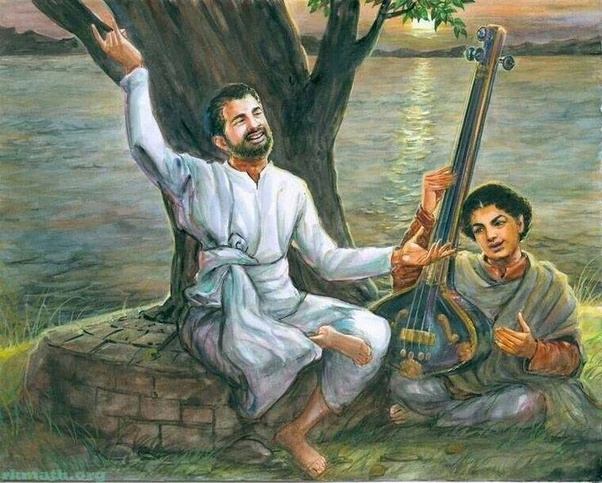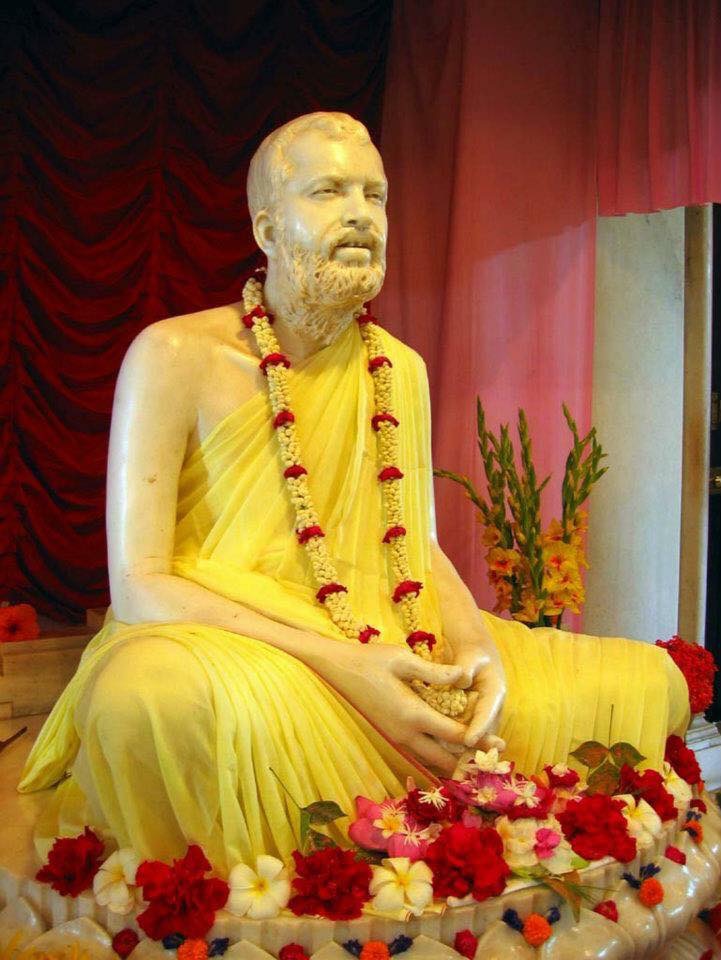(Continued from previous issue. . .)
In the previous article we saw Sri Ramakrishna engage in a long conversation with the Bose brothers, and then leave for Golap-ma’s house. His memorable visit to this humble devotee’s house is presented here.
Golap-ma had been busy the whole day making arrangements to receive Sri Ramakrishna. He had promised to visit her home from Basu Bati, the residence of the Bose brothers. She was a Brahmin widow and lived with her widowed sister and her brothers with their families. In her restless anticipation, she came out every few minutes to see if Sri Ramakrishna was coming. Because of the delay in his coming, she feared that he might not come at all. Unable to bear the thought, she went to check at Basu Bati which was just 260 meters away from her house.
Who was Golap-ma?
Golap Sundari Devi, known as Golap-ma was born into a brahmin family of North Calcutta, probably in the late 1840s. Her parents had given her in marriage to a poor Brahmin who unfortunately died after a few years, leaving her with two small children – a son and a daughter. When her son was still very young, he also died. Then her daughter Chandi became the anchor of her life. Chandi was a charming, well-mannered girl. When she grew up, despite being poor, Golap-ma was able to arrange her marriage to Sourindra Mohan Tagore (1840-1914)1 a wealthy landlord of Pathuriaghata, Calcutta. Sourindra was also a well-known Bengali musicologist and had founded the Bengali School of Music and the Bengali Academy of Music.
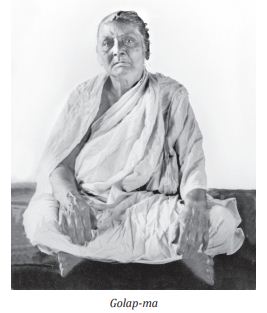
Golap-ma’s heart would swell with pride whenever her daughter visited her humble two-storied home escorted by security guards. But fate had another cruel blow in store for her. Chandi died in June 1885, creating a tremendous void in her mother’s life. Golap-ma was terribly grief-stricken.
It was only around six weeks after this tragedy that she was eagerly waiting to receive Sri Ramakrishna into her home and heart.
Unlike ordinary souls who are enveloped by the five stages of grief,2 Golap-ma was eager to free herself from her intense suffering. The Lord’s grace intervened in the form of her neighbor Yogin-ma. Eager to assuage the pain of Golap-ma, one day in 1885 Yogin-ma took her to Sri Ramakrishna.
How did Sri Ramakrishna assuage Golapma’s grief?
Sri Ramakrishna gave Golap-ma’s intense grief a God-ward turn and transformed it into vyakulata or intense yearning for the Lord. In her first meeting with Sri Ramakrishna, on June 13, 1885, at Ram Datta’s house, as soon as Golap-ma entered the room, without addressing her directly, Sri Ramakrishna said, “A man came here the other day. He sat a few minutes and then said, ‘Let me go and see the moonface of my child.’ I couldn’t control myself and said, ‘So you prefer your son’s “moon-face” to God’s “moon-face”! Get out, you fool!’ The truth is that God alone is real and all else is unreal.”3
Here Sri Ramakrishna is hinting that spiritual aspirants should give their minds a God-ward turn or ‘Mor firiye dao’ as he would put it in Bengali. Though Golap-ma felt solace in the presence of Sri Ramakrishna, nonetheless, Sourindra Mohan Tagore Pathuriaghata Castle grief still scorched her heart when she returned home. Almost every day, she would run like a madwoman from her home to Dakshineswar (9.4 kilometers) to see Sri Ramakrishna in the hope of getting some relief from her pain.
After Golap-ma had unburdened her heart to Sri Ramakrishna by narrating the sad story of her life, he said in an ecstatic mood: “You are fortunate. God helps those who have no one to call their own.”4 Golap-ma later said: “When I first went to the Master I was tormented with grief for my daughter, Chandi. Yogin took me to him. He touched my head and removed all grief from my heart. It was amazing. In a moment my mind became calm and serene. I immediately laughed like a jnani. I felt that I had come to this world to act in a play. Who is whose mother and who is whose daughter? In my childhood I had played with cloth dolls, and after that I played with flesh-and-blood dolls. This world is nothing but a play with dolls, so why should I cry for my daughter? It is a glorious thing to cry for God. Such was the power of the Master!”
Sri Ramakrishna also kept an eye on her practical needs. He sent her to Holy Mother with the instruction: “You should feed this brahmin girl well. Sorrow is assuaged when the stomach is full.”5
Against this backdrop of grief and longing, Golap-ma had spent the entire afternoon anxiously awaiting Sri Ramakrishna’s arrival. When she ran to Basu Bati, she found out there that Sri Ramakrishna had already left. Then where could he have gone?
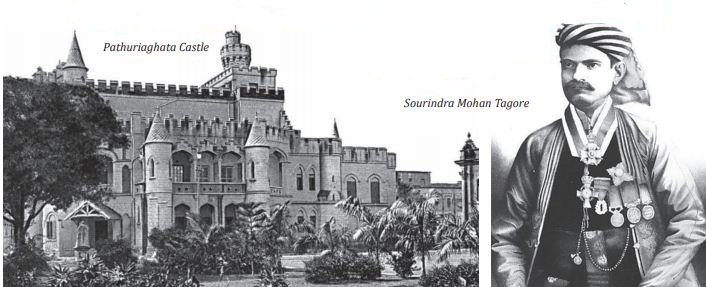
In the meanwhile, in her absence Sri Ramakrishna had arrived at her house. Entering the old brick house, he passed the cow-shed on his left, which no longer exists. He and the devotees went to the roof and sat there. Some people were standing in rows while some were seated. They were all eager to have a glimpse of Sri Ramakrishna. Sri Ramakrishna was seated on a carpet. Mahendranath Gupta [referred to as M.,], Narayan, Yogin, Devendra, and others were seated on a mat. A few minutes later the younger Naren and some other devotees arrived. The brahmani’s [wife of a Brahmin] sister came to Sri Ramakrishna, saluted him, and informed that her sister had gone to Nanda Bose’s house to know why Sri Ramakrishna had been delayed. A sound was heard downstairs and she exclaimed, ‘There she comes!’ She went down. But it was not the brahmani.
Sri Ramakrishna sat there smiling, surrounded by devotees.
M. (to Devendra): “What a grand sight! All these people — young and old, men and women — standing in lines, eager to have a glimpse of him and hear his words.” Devendra (to the Master): “M., says that this place is better than Nanda’s. The devotion of these people is amazing.”
Sri Ramakrishna laughed.
Here, M., points out the sharp contrast between Basu Bati and Golap-Ma’s house. Basu Bati was a luxurious palace with holy pictures, yet the atmosphere of sincere devotion was not present—but here the spiritual devotion of simple people gathered at Golap-ma’s humble house was palpable. It reminds us of the famous saying in the Bible, “Blessed are the poor in heart, for they shall see God.”6
The brahmani’s sister exclaimed, “Here comes sister!” Golap-ma came and saluted the Master. She was beside herself with joy. She did not know what to say. In a half-choked voice she said: “This joy is too much for me. Perhaps I shall die of it. Tell me, friends, how shall I be able to live? I did not feel such a thrill even when Chandi, my daughter, used to visit the house accompanied by liveried footmen, with armed guards lining both sides of the street. Oh! Now I have no trace of my grief at her death. I was afraid he [meaning Sri Ramakrishna] would not come. Then I thought that, if that happened, I should throw into the Ganges all the things I had arranged for his reception and entertainment. I should not speak to him any more. If he visited a place, I should go there, look at him from a distance, and then come away.”
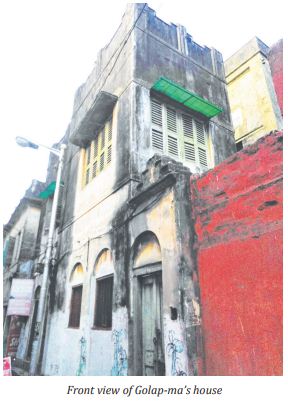
“Let me go and tell everybody how happy I am. Let me go and tell Yogin of my good luck.”
Still overwhelmed with joy, she exclaimed, “A labourer won a hundred thousand rupees in a lottery. The moment he heard the news he died of joy. Yes, he really and truly died. I am afraid the same thing is going to happen to me. Please bless me, friends, or else I shall certainly die.”
Here we see the great miracle of Sri Ramakrishna. Just a few weeks ago, she had been plunged into an abyss of despair when her daughter passed away. But now, she no longer had any trace of that grief, and her happiness at seeing Sri Ramakrishna had exceeded all bounds.
Sri Ramakrishna described to M., the different stages of bhakti: “How can a devotee attain such love? First, the company of holy men. That awakens shraddha, faith in God. Then comes nishtha, singled-minded devotion to the Ideal… He performs only acts that please God. After nishtha comes bhakti, devotion to God; then comes bhava. Next, mahabhava, then prema, and last of all the attainment of God Himself.”7
In this visit, Golap-ma attained the Lord himself in Sri Ramakrishna, the final stage of bhakti, or parabhakti.
M., was amazed to see the brahmani’s sincere joy and her ecstatic mood. He was about to take the dust of her feet. “What are you doing?” she exclaimed, and saluted M.
Golap-ma was extremely happy at the sight of the devotees. She said: “I am so happy to see you all here. I have brought the younger Naren; without him, who would there be to make us laugh?”
She was talking like this when her sister came up and said: “Come down, sister! How can I manage things if you stay here? Can I do it all by myself ?” But the brahmani was overwhelmed with joy. She could not take her eyes off the Master and the devotees.
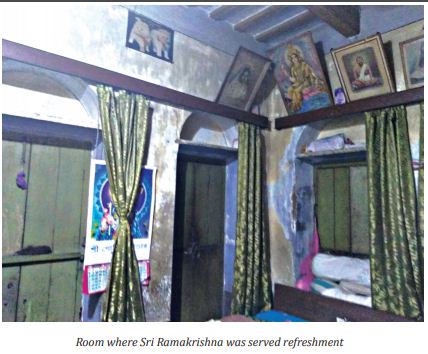
Comparison with Martha and Mary
Later that night, referring to this condition of the two widowed sisters, M., told Sri Ramakrishna that a similar incident had taken place when Jesus Christ visited the house of his devotees – the two sisters Martha and Mary. At the sight of Jesus, Mary was filled with ecstatic happiness.8 Left alone to arrange the food to entertain Jesus, Martha complained to Jesus: “Lord, please judge for Yourself—how wrong my sister is! She is sitting in your room and I am doing all these things by myself.” Jesus said: “Your sister indeed is blessed. She has developed the only thing needful in human life: love of God.’”9 When vyakulata or divine restlessness for God intensifies, it transforms into divine love or parabhakti. In this condition, the devotee forgets his duties, like serving the Lord as seen with Golap-ma and Mary. Through Golap-ma’s case, Sri Ramakrishna showed how grief can be turned into ecstatic love for God.
After a while, Golap-ma very respectfully took Sri Ramakrishna to a room inside the house and offered him sweets and other refreshments. The devotees were entertained on the roof.
It was about eight o’clock in the evening. Sri Ramakrishna was ready to leave. A man showed the way with a light. In places it was dark. Sri Ramakrishna stood in front of the cow-shed. M., saluted him here and the devotees gathered around him. From here, they would walk to Yogin-ma’s house.
(To be continued…)
References
- In music, Shaurindra Mohan Tagore (d. 1914) made a comparative study of Eastern and Western music and was awarded the degree of Doctor of Music by Philadelphia University in 1875. He also earned another Ph.D. at Oxford University in 1896. He founded the Banga Sangit Vidyalaya in 1871 and the Bengal Academy of Music in 1881. Shourindra Mohan was honoured by the Shah of Iran with the title of Nawab Shahzada, and the British government made him a Knight Bachelor of the United Kingdom.
- According to the Ross-Kubler Model, the five stages of grief are denial, anger, bargaining, depression, and acceptance https://www.psycom.net/depression. central.grief.html.
- The Gospel of Sri Ramakrishna [hereafter Gospel], p. 787
- They Lived with God (2016), p. 377
- Ibid, p. 379
- Beatitude 6. The Beatitudes are eight blessings recounted by Jesus in the Sermon on the Mount in the Gospel of Matthew. [Matthew 5: 8]
- Gospel, p. 503
- See Luke 10:38-41
- Gospel, p. 825
Source : Vedanta Kesari, August, 2020
